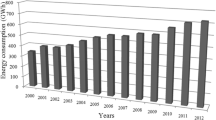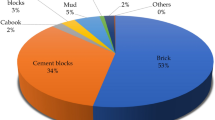Abstract
Uninsulated concrete block walls commonly found in tropical region have to be retrofitted to save energy. The thickness of insulation layer used can be reduced with the help of modified laterite based bricks layer (with the considerably lower thermal conductivity than that of concrete block layer) during the retrofit building fabrics. The aim of this study is to determine the optimum location and distribution of different materials. The investigation is carried out under steady periodic conditions under the climatic conditions of Garoua in Cameroon using a Simulink model constructed from H-Tools (the library of Simulink models). Results showed that for the continuous air-conditioned space, the best wall configuration from the maximum time lag, minimum decrement factor and peak cooling transmission load perspective, is dividing the insulation layer into two layers and placing one at the exterior surface and the other layer between the two different massive layers with the modified laterite based bricks layer at the interior surface. For intermittent cooling space, the best wall configuration from the minimum energy consumption depends on total insulation thickness. For the total insulation thickness less than 8 cm approximately, the best wall configuration is placing the half layer of insulation material at the interior surface and the other half between the two different massive layers with the modified earthen material at the exterior surface. Results also showed that, the optimum insulation thickness calculated from the yearly cooling transmission (estimated only during the occupied period) and some economic considerations slightly depends on the location of that insulation.













Similar content being viewed by others
Abbreviations
- A s :
-
Annual energy savings ($ . m−2)
- C :
-
Specific heat (J . kg−1 . K−1)
- C :
-
Cost ($)
- COP :
-
Coefficient of performance of air-conditioning system
- G :
-
Inflation rate (%)
- h :
-
Convection and/or radiation heat transfer coefficient (W . m−2 . K−1)
- L :
-
Wall thickness (m)
- L op :
-
Optimum insulation thickness (m)
- I :
-
Interest rate (%), order of node
- I :
-
Total solar radiations on the horizontal surface (W . m−2)
- I b :
-
Direct solar radiations on the horizontal surface (W.m−2)
- I d :
-
Diffuse solar radiations on the horizontal surface (W . m−2)
- N :
-
Number of nodes
- n :
-
Lifetime of building (years)
- M :
-
Number of layers of composite wall
- p b :
-
Payback period (years)
- Q c :
-
Annual cooling transmission load (MJ . m−2)
- R d :
-
Diffuse radiation conversion factor
- T :
-
Time (s)
- T :
-
Temperature (°C)
- x :
-
Coordinate direction normal to wall (m)
- Α :
-
Solar absorptivity of outside surface of wall
- β :
-
Tilted surface angle (°)
- δ :
-
Declination angle (°)
- Λ :
-
Thermal conductivity (Wm−1 K−1)
- ϕ :
-
Latitude (°)
- ω :
-
Hour angle (°)
- ω s :
-
Sunset-hour angle for a horizontal surface (°)
- ρ :
-
Density of material (kg.m−3)
- ρ r :
-
Ground reflectivity
- El :
-
Electricity
- Enr :
-
Energy
- I :
-
Inside
- in :
-
Interior
- Ins :
-
Insulation
- o :
-
Outside
- Sa :
-
Solar-air
- t :
-
Total
References
Goodhew S, Griffiths R (2005) Sustainable earth walls to meet the building regulations. Energy Build 37:451–459
Morel JC, Mesbah A, Oggero M, Walker P (2001) Building houses with local materials: means to drastically reduce the environmental impact of construction. Build Environ 36:1119–1126
Bribián IZ, Capilla AV, Usón AA (2011) Life cycle assessment of building materials: comparative analysis of energy and environmental impacts and evaluation of the eco-efficiency improvement potential. Build Environ 46:1133–1140
Taylor P, Fuller RJ, Luther MB (2008) Energy use and thermal comfort in a rammed earth office building. Energy Build 40:793–800
Pacheco-Torgal F, Jalali S (2012) Earth construction: lessons from the past for future eco-efficient construction. Constr Build Mater 29:512–519
Collet F, Serres L, Miriel J, Bart M (2006) Study of thermal behaviour of clay wall facing south. Build Environ 41:307–315
Binici H, Aksogan O, Bodur MN, Akc E, Kapur S (2007) Thermal isolation and mechanical properties of fibre reinforced mud bricks as wall materials. Constr Build Mater 21:901–906
Meukam P, Jannot Y, Noumowe A, Kofane TC (2004) Thermo physical characteristics of economical building materials. Constr Build Mater 18:437–443
Bal H, Jannot Y, Gaye S, Demeurie F (2013) Measurement and modelisation of the thermal conductivity of a wet composite porous medium: laterite based bricks with millet waste additive. Constr Build Mater 41:586–593
Ozkahraman HT, Bolatturk A (2006) The use of tuff stone cladding in buildings for energy conservation. Constr Build Mater 20:435–440
Ozel M, Pihtili K (2007) Optimum location and distribution of insulation layers on building walls with various orientations. Build Environ 42:3051–3059
Al-Sanea SA, Zedan MF, Al-Hussain SN (2012) Effect of thermal mass on performance of insulated building walls and the concept of energy savings potential. Appl Energy 89:430–442
Ibrahima M, Biwole PH, Wurtz E, Achard P (2014) A study on the thermal performance of exterior walls covered with a recently patented silica-aerogel-based insulating coating. Build Environ 81:112–122
Al-Sanea SA, Zedan MF (2011) Improving thermal performance of building walls by optimizing insulation layer distribution and thickness for same thermal mass. Appl Energy 88:3113–3124
Kossecka E, Kosny J (2002) The influence of insulation configuration on heating and cooling loads in a continuously used building. Energy Build 34:321–331
Tsilingiris PT (2006) Wall heat loss from intermittently conditioned spaces- the dynamic influence of structural and operational parameters. Energy Build 38:1022–1031
Bojic M, Yik F, Sat P (2001) The influence of thermal insulation position in building envelope on the space cooling of high rise residential buildings in Hong Kong. Energy Build 33:569–581
Barrios G, Huelsz G, Rojas J (2012) Thermal performance of envelope wall/roofs of intermittent air-conditioned rooms. Appl Therm Eng 40:1–7
Ozel M (2014) Effect of insulation location on dynamic heat-transfer characteristics of building external walls and optimization of insulation thickness. Energy Build 72:288–295
Perez R, Ineichen P, Seals R (1990) Modeling of daylight availability and irradiance components from direct and global irradiance. Sol Energy 44:271–289
Claessens J, Coulibaly Y, Kemajou A, (2014) Efficacité energétique de la climatisation en région tropicale. <www.ifdd.francophonie.org/docs/prisme/ee TOME1.PDF>, [accessed 20.09.14]
Samri D (2008) Analyse physique et caractérisation hygroscopique des matériaux de construction : approche expérimental et modélisation numérique. Thèse de Doctorat, Institut National des Sciences Appliquées de Lyon
Daouas N (2011) A study on optimum insulation thickness in walls and energy savings in Tunisian buildings based on analytical calculation of cooling and heating transmission loads. Appl Energy 88:156–164
Wati E, Meukam P, Nematchoua KM (2015) Influence of external shading on optimum insulation thickness of building walls in a tropical region. Appl Therm Eng 90:754–762
Ozel M (2013) Determination of optimum insulation thickness based on cooling transmission load for building walls in a hot climate. Energy Convers Manag 66:106–114
Kalagasidis AS (2003) The whole model validation for HAM-Tools. Case study: hygro-thermal conditions in the cold attic under different ventilation regimes and different insulating materials. Report R:03–6, 2003. Department of Building Technology, Chalmers University of Technology, Gothenburg, Sweden. Also available for free downloading on www.ibpt.org
Ibpt library. IBPT-1. (2014) <http://www.ibpt.org/libraries.html>, [accessed 12.05.14].
Nielsen TR, Peuhkuri R, Weitzman P, Gudum C. (2002) Modeling Building Physics in Simulink, Report SR-02-03, BYG DTU
Crawley DB, Lawrie LK, Winkelmann FC, Buhl WF, Huang YJ, Pedersen CO, Strand RK, Liesen RJ, Fisher DE, Witte MJ, Glazer J (2001) EnergyPlus: creating a new-generation building energy simulation program. Energy Build 33(4):319–331
Witte MJ, Henninger RH, Glazer J, Crawley DB, (2001) Testing and validation of a new building energy simulation program, Proceedings of Building Simulation 2001, IBPSA
Arıcı M, Karabay H (2010) Determination of optimum thickness of double-glazed windows for the climatic regions of Turkey. Energy Build 42:1773–1778
Inflation, consumer prices (annual %) (2014) <http://data.worldbank.org/indicator/FP.CPI. TOTL.ZG>, [accessed 29.08.14].
Prêt Foncier Epargne Logement Ordinaire. (2014) <http://www.creditfoncier.cm/index. php/fr/pret-foncier-epargne-logement/pret-foncier-epargne-logementordinaire>, [accessed 29.08.14].
Al-Homoud MS, Abdou AA, Budaiwi IM (2009) Assessment of monitored energy use and thermal comfort conditions in mosques in hot-humid climates. Energy Build 41(6):607–614. doi:10.1016/ j.enbuild.2008.12.005
Suehrcke H, Peterson EL, Selby N (2008) Effect of roof solar reflectance on the building heat gain in a hot climate. Energy Build 40:2224e2235
Asan H (2006) Numerical computation of time lags and decrement factors for different building materials. Build Environ 41:615–620
Acknowledgements
The authors would like to acknowledge the Department of National Meteorology of Cameroon for providing the long-term dry bulk air temperature data.
Author information
Authors and Affiliations
Corresponding author
Additional information
Highlights
• Thermal retrofit solutions of walls using laterite and insulation layers were studied.
• Optimum configuration of fixed resistance and capacitance walls was determined.
• Comparative performance of some configurations depends on insulation thickness.
• Insulation thicknesses of walls were optimized for intermittent air-conditioned space.
Rights and permissions
About this article
Cite this article
Wati, E., Meukam, P. & Damfeu, J.C. Modeling thermal performance of exterior walls retrofitted from insulation and modified laterite based bricks materials. Heat Mass Transfer 53, 3487–3499 (2017). https://doi.org/10.1007/s00231-017-2059-7
Received:
Accepted:
Published:
Issue Date:
DOI: https://doi.org/10.1007/s00231-017-2059-7




